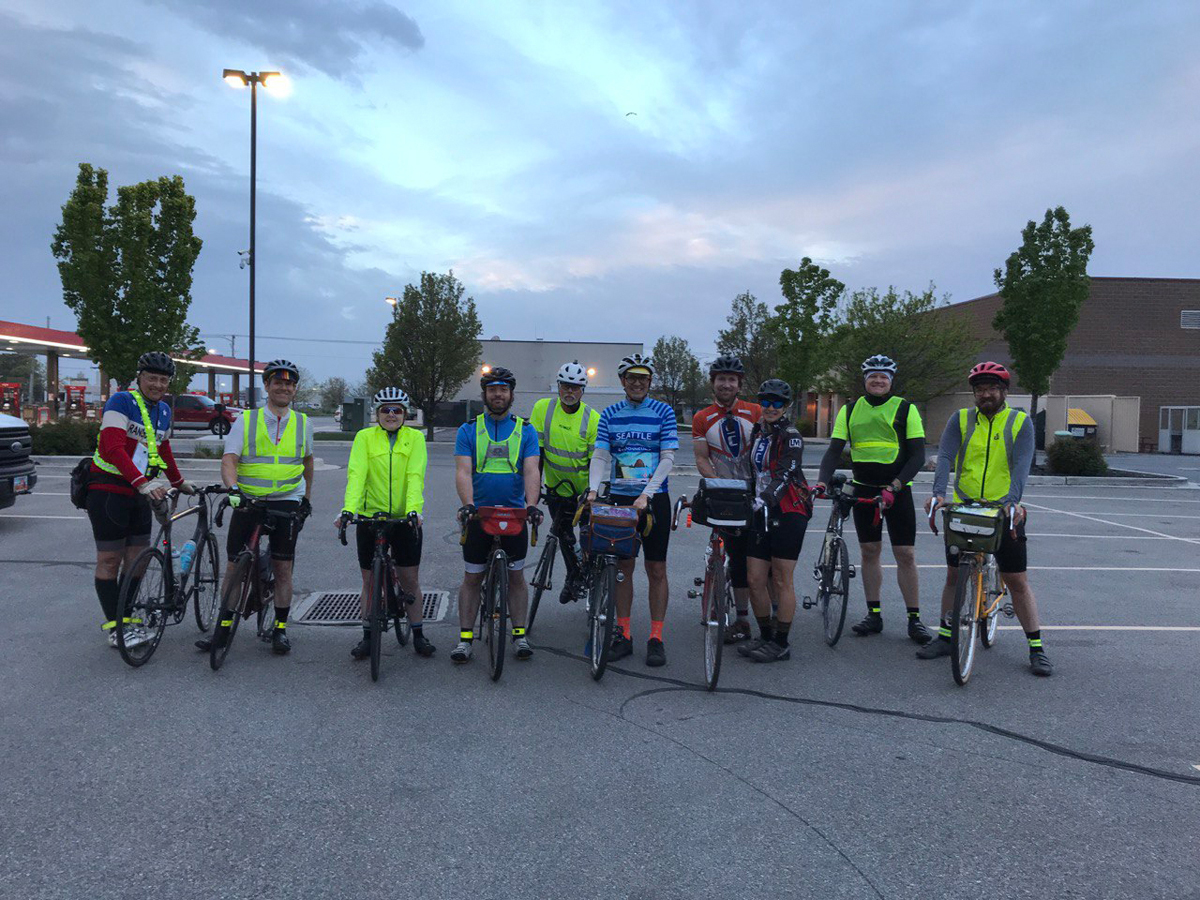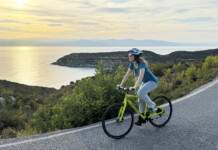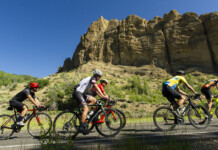By Kelly McPherson — In July, I am planning to do this crazy ride starting on July 11 in Canada and riding my bike along I89 until I reach Mexico on July 28 over 1750 miles later. My riding partner, Shem Flitton and I are using the ride to raise funds for Huntsman Cancer Institute. If you would like to donate, we would LOVE it, and you can do so by clicking on the link below. https://hope.huntsmancancer.org/diy/krazykelly If you would like to follow our adventure, follow us on https://www.facebook.com/Rideon89 or https://ride89.org/ In preparation for riding 100-150 miles a day for almost 3 weeks, I need to get a lot of training in. I need to do a lot of long rides! Someone pointed me towards the Salt Lake Randonneurs. https://www.facebook.com/SaltLakeRandos
What is a Randonneur? A Randonneur is a rider who rides ultra-long distances along a prescribed course that is not marked and has no aid stations. This is a completely self-supported ride fueled by what you bring or what you pick up at gas stations along the way, usually at least 200k in distance.

I figured that this style of riding would be good training for Ride89 in July. Our local Salt lake Randonneurs have a schedule of events on their website https://www.saltlakerandos.org/ I couldn’t ride the first one due to scheduling conflicts, but was able to ride the second one on May 7, the Wasatch Front/Antelope Island 200k/300k Brevet. Being new to this style of riding and not having ridden more than 70 miles this year so far, I wisely chose the 200k.
I began doing research on randonneuring and found that there wasn’t much out there to find. Having done some really long rides in the past, I started to think about what I would need to bring and prepare for to ride 125 miles unsupported. All of the rides that I had done of that length in the past were supported with SAG vehicles, course markings and aid stations at regular intervals along the course. I was fairly sure I could do the distance, but I was worried about getting lost or running out of food and water or having a mechanical that I wasn’t able to fix.
I began by buying some new bags for my bike as I would need to carry most of what I would need as stopping at every gas station would just slow me down. I chose a Rockbros Bike Frame Bag which was significantly larger than one that I had previously been using. I also got a Wildken Big Saddle Bag that was much larger than my current seat bag and had the benefit of being able to carry another water bottle.
Then I set myself to the task of figuring out what food to bring. I’ve never been really good at my nutrition and tend to bonk at about 60 miles. This is something I really needed to get nailed down if I am to be successful with Ride89. I put together a spreadsheet that helped me calculate how many calories I was going to need for the expected duration and how many of which foods I would need to meet that calorie goal. I played with a lot of foods, but finally came across what I think will work. It’s a combo of salted caramels, golden double stuff Oreos, Rice Krispie treats, PB&J sandwiches and two-bit chicken, sweet potato, and rice pies. Yum!
The next task I needed to complete was to finally figure out how to download a map to follow on my Wahoo Elemnt Bolt. I am embarrassed to say that after almost 20 years of riding, I still didn’t know how to do this. All of my courses have been self-designed, had someone to follow or were clearly marked. Gratefully, it isn’t all that hard once you find and read instructions.
The night before the Brevet, I nervously prepared and packed my food, water bottles and extra electrolyte drink mix. I packed extra tubes, CO2, bike tools, ChapStick, allergy pills, ibuprofen, and a host of other things that I wouldn’t want to be stranded without. I checked and double checked my map on my Elemnt.
I woke up incredibly early the morning of the Brevet to load my bike and drive to our starting point, a Maverick in North Salt Lake. It was a small and interesting group. Sleek road bikes were few in favor of heavier bikes with mud guards. I had been nervous that the large bags that I had put on my bike would look silly to the other riders. They did. They were way too small compared to their large handlebar bags and panniers.
They were friendly and every one of them made a point of getting to know my name and chatting with me for a bit. It was nice!
Most of the group was doing the 300k, but we all started out at the same time and rode fairly casually over back roads by the airport and then through downtown Salt Lake. We got stopped at EVERY single light on our way up to Emigration Canyon, but no one seemed to really care. It was going to be a long day and patience was crucial.
The flip point for the 200k was at the top of Emigration while the 300k continued up Big Mountain and onto destinations eastward. A couple of guys saw me coming up the climb as they were coming down, flipped to chat with me at the top and then ride with me for the rest of the course. Wow! That would never happen in some of the races I have been in.
The 200k course took us back through downtown, onto Jordan River Parkway trail for a short bit and then Legacy Parkway for a long way and then up to Antelope Island. We turned around part of the way out to the ranch and headed back the way we came. It was 125 miles total and really was a lot of fun. I would totally do this again.
I learned a few things. First, 125 miles is a long way and I need to do a lot more of these in training for July’s Ride 89 ride. Getting more calories in made riding the distance a lot easier. Carefully planning things rather than just throwing what I have on hand in my jersey pockets made it so I didn’t bonk. Yeah! I also learned that my Rockbros frame bag was nice to fit everything in, but it got in the way of my knees when I stood. Maybe the handlebar bags the others were using would be better? My larger saddle bag was really nice but putting a water bottle in it made it rub on my rear tire. I either need to leave the bottle out or put on a fender. It rubbed enough to wear a hole in the bag. I loved the map on my Elemnt. It was perfect! I had come prepared to have Ridewithgps loaded on my phone and an earbud so it could talk to me, but I was worried it would wear my battery down too quickly. I am glad I didn’t need to use it. I don’t like using earbuds when I ride anyway.
Overall, I am intrigued by this style of riding. Due to scheduling conflicts, I won’t be able to do any more Salt Lake Randonneur events this year, but likely will next year as well as try a few others in other areas. It looks like fun and like it might be a style of riding that I could be relatively good at.
Again, if you are curious about our Ride 89 event in July, please feel free to follow us at https://ride89.org/ https://www.facebook.com/Rideon89 or donate at https://hope.huntsmancancer.org/diy/krazykelly
Kelly is a 40+ cyclist who lives in South Jordan UT with her husband of 27 years and 5 kids. She has a BS in Health Education from the University of Utah and loves to stay healthy and fit and take as many people with her as she can.








Great article! Kelly did an excellent job of describing the riders and the course. RUSA.org is the Web site for the national organization. It’s a good source of information if you ride other places, too.
I live in Idaho, but there isn’t any local organization or many randonneurs here, so I ride in Oregon, Washington, and Utah. I love riding in Utah. The courses are excellent and the people are awesome. Some years, I do multiple brevets there. Due to scheduling conflicts, I only did one in Utah this year. It happened to be this one!
Great article Kelly! Now you are a Randonneuse (French for a female rando rider) Indeed keep at it, it’s a habit forming adventurer.
Comments are closed.